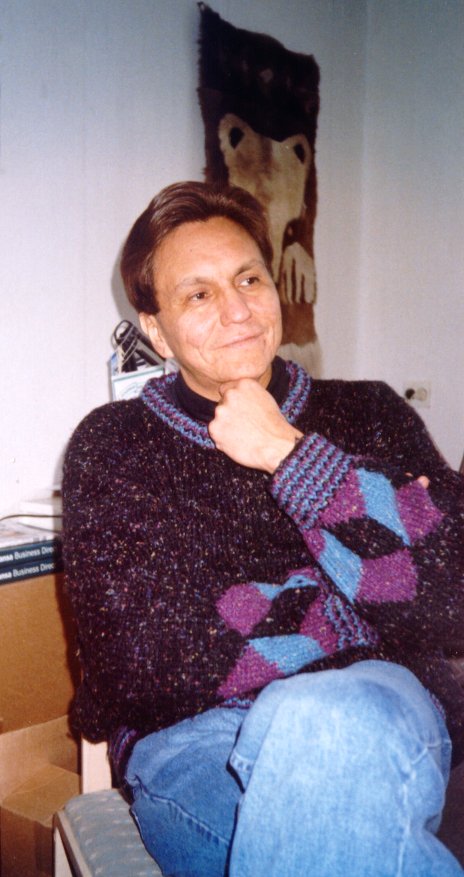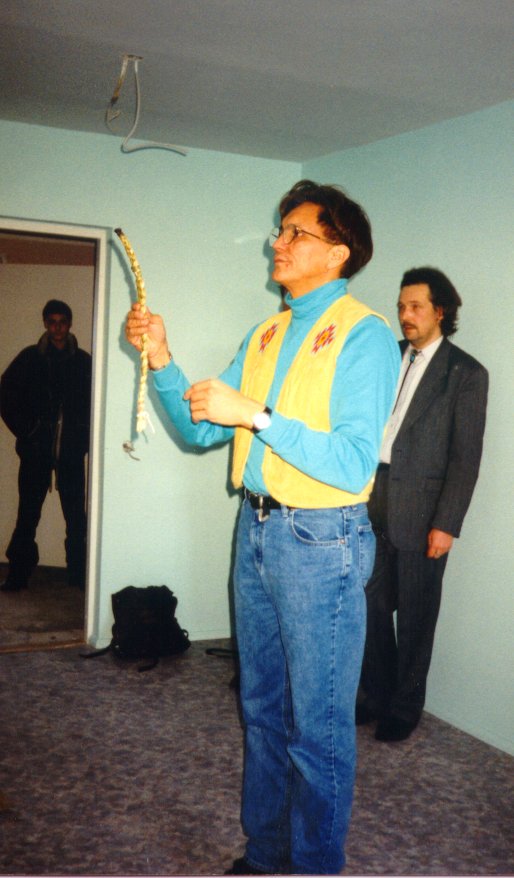Finno-Ugric Peoples Have Much to Learn from
the Indians
(by Kerti Tergem)
 From March 2 to 9 Wesley Stevenson, Executive
Director of Finance and Administration of the Saskatchewan Indian Federated College
was the guest of the Fenno-Ugria Foundation in Estonia. His main
interest was to promote contacts between his College and the
universities of Estonia and to further the establishing of the
Centre of Indigenous Peoples in Tartu. In Tallinn, Tartu (Tartu
University) and Viljandi
(Viljandi College of Culture)
he also delivered lectures on the Canadian Indian reserve life in
the early 20th century.
From March 2 to 9 Wesley Stevenson, Executive
Director of Finance and Administration of the Saskatchewan Indian Federated College
was the guest of the Fenno-Ugria Foundation in Estonia. His main
interest was to promote contacts between his College and the
universities of Estonia and to further the establishing of the
Centre of Indigenous Peoples in Tartu. In Tallinn, Tartu (Tartu
University) and Viljandi
(Viljandi College of Culture)
he also delivered lectures on the Canadian Indian reserve life in
the early 20th century.
Since 1492, when Indians discovered Columbus, American history
has been portrayed from the suppressor's point of view. So the
Indian Administration decided to create their own educational
system to educate Indians the best way they know. And they have
proved to be effective. The Saskatchewan Indian Federated
College, established in 1976 is an independently administrated
University College, all its programs being fully accredited
through the University of Regina. The College has over 50
full-time faculties and has developed a unique Indian curriculum.
Among other subjects, the Indian College prepares specialists in
Indian Social Work, Indian Management and Administration herewith
supporting its students in entering the mainstream population.
85% of the students are of first nations (as the Indians call
themselves).
Mr Stevenson is a Cree Indian, member of the biggest Indian
tribe in Canada, numbering 185 thousand. This is almost one third
of the whole Indian population there. What distinguishes them
from their neighbouring tribes, Mr Stevenson said, half joking,
is that they are very lucky. Though, for the Indian people in
Canada "the rivers stopped flowing and the sun stopped
shining a long time ago".
The Centre of Indigenous Peoples. Why in
Estonia?
Today there are more than 80 Finno-Ugrian students studying at
the universities of Estonia. They have to get an education which
meets the needs of their homeland on one hand, while on the other
hand, like the Indians, they need a structure to protect their
identity amid a culture seemingly similar. The Indian Federated
College seemed to be appropriate for sharing their experience of
generating such a system in Estonia. Because of technical
resources available today this period in the history of the
Baltics provides an opportunity that was not there in the past
and maybe will not be there in the future. And as far as
government agencies are willing to provide money for a reform of
the Baltic States at the moment, as Mr Stevenson pointed out,
there will be a good chance for the Indian College to expand
their international programme. For this particular reason Mr
Stevenson met the minister of culture of Estonia and the rector
of Tartu University. The key
figures of the University understood the necessity of
establishing a system which would help the Finno-Ugric students
of Estonia to integrate into our academic society and to provide
a cultural environment which supports their identity. This is a
big challenge. Mr Stevenson found that if we succeed in
establishing such a Centre it will be rewarding.
The mental attitude of Indians and Estonians is
similar
Before making important decisions the Cree Indians burn
sweetgrass. "With this smoke, that is looked at as a symbol
of sacredness you purify your words, your mouth, so that you
speak the truth, and your eyes and your ears so that you will see
clearly and you hear other people," Mr Stevenson explained.
Proper hearing of other people is particularly important for the
Indian people. That is the precondition for starting any
cooperation. Mr Stevenson found that the long history of
repression and efforts to maintain our own identity have
generated similar characteristics to the Estonians and the
Indians. The recognition of the importance of maintaining ones
identity that Mr Stevenson met in Estonia gave him additional
reason to believe even deeper in the necessity of the College he
works for in Canada.
Grassroots nourish our urge for survival
 Both Indian and Finno-Ugric peoples rely
ever so much upon Mother Earth, they live harmoniously to
survive. Mr Stevenson felt that connections with our roots must
have helped the Estonians survive the long history under
domination. He particularly enjoyed his trip to South Estonia and
he thinks that the area of Viljandi continues to be the protector
of Estonian traditional culture. For good hope to the future
contacts of the Indian and the Finno-Ugric peoples Mr Stevenson
carried out a traditional Indian purifying ritual at the new
rooms of the Estonian-Mordvin, -Mari and -Saami Societies,
burning sweetgrass.
Both Indian and Finno-Ugric peoples rely
ever so much upon Mother Earth, they live harmoniously to
survive. Mr Stevenson felt that connections with our roots must
have helped the Estonians survive the long history under
domination. He particularly enjoyed his trip to South Estonia and
he thinks that the area of Viljandi continues to be the protector
of Estonian traditional culture. For good hope to the future
contacts of the Indian and the Finno-Ugric peoples Mr Stevenson
carried out a traditional Indian purifying ritual at the new
rooms of the Estonian-Mordvin, -Mari and -Saami Societies,
burning sweetgrass.
"Smoke is looked at as a symbol of sacredness. You purify
your words, and your mouth so that you speak the truth, and your
eyes and your ears so that you will see clearly and you hear
other people," Stevenson says, adding that proper hearing of
other people is particularly important for the Indian people when
starting any cooperation.
A slightly different edition of this
article was published in The Baltic Times (May
2-8, 1996) and an Estonian
edition in Fenno-Ugria
Infoleht (No. 1/1996)
Read
this article in Estonian
See artikkel eesti keeles
Back
 From March 2 to 9 Wesley Stevenson, Executive
Director of Finance and Administration of the Saskatchewan Indian Federated College
was the guest of the Fenno-Ugria Foundation in Estonia. His main
interest was to promote contacts between his College and the
universities of Estonia and to further the establishing of the
Centre of Indigenous Peoples in Tartu. In Tallinn, Tartu (Tartu
University) and Viljandi
(Viljandi College of Culture)
he also delivered lectures on the Canadian Indian reserve life in
the early 20th century.
From March 2 to 9 Wesley Stevenson, Executive
Director of Finance and Administration of the Saskatchewan Indian Federated College
was the guest of the Fenno-Ugria Foundation in Estonia. His main
interest was to promote contacts between his College and the
universities of Estonia and to further the establishing of the
Centre of Indigenous Peoples in Tartu. In Tallinn, Tartu (Tartu
University) and Viljandi
(Viljandi College of Culture)
he also delivered lectures on the Canadian Indian reserve life in
the early 20th century. Both Indian and Finno-Ugric peoples rely
ever so much upon Mother Earth, they live harmoniously to
survive. Mr Stevenson felt that connections with our roots must
have helped the Estonians survive the long history under
domination. He particularly enjoyed his trip to South Estonia and
he thinks that the area of Viljandi continues to be the protector
of Estonian traditional culture. For good hope to the future
contacts of the Indian and the Finno-Ugric peoples Mr Stevenson
carried out a traditional Indian purifying ritual at the new
rooms of the Estonian-Mordvin, -Mari and -Saami Societies,
burning sweetgrass.
Both Indian and Finno-Ugric peoples rely
ever so much upon Mother Earth, they live harmoniously to
survive. Mr Stevenson felt that connections with our roots must
have helped the Estonians survive the long history under
domination. He particularly enjoyed his trip to South Estonia and
he thinks that the area of Viljandi continues to be the protector
of Estonian traditional culture. For good hope to the future
contacts of the Indian and the Finno-Ugric peoples Mr Stevenson
carried out a traditional Indian purifying ritual at the new
rooms of the Estonian-Mordvin, -Mari and -Saami Societies,
burning sweetgrass.